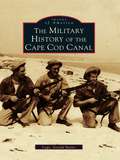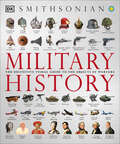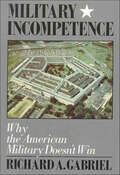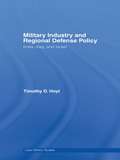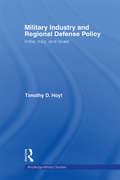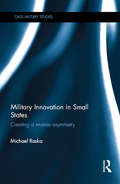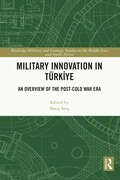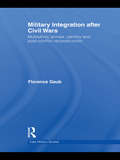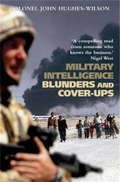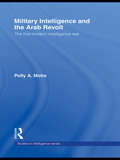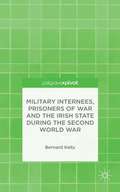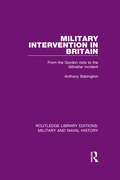- Table View
- List View
Military History of the Cape Cod Canal, The (Images of America)
by Capt. Gerald ButlerDuring World War II, with Allied merchant and navy ships under the threat of German U-boats, the eastern seaboard was on high alert. The Cape Cod Canal, a vital waterway for commercial and military traffic, underwent a period of strict control, occupation, and defense. This pictorial history documents the activity during that time and the extensive array of weaponry and manpower brought to bear in coastal defense.In The Military History of the Cape Cod Canal, the abandoned foundations at Sagamore Hill and throughout most of Buzzards Bay are explored, as well as the weapons, devices, and personnel assigned to ensure the canal's integrity throughout the war. Although the responsibilities of the U.S. Army's Coast Artillery are a focal point, the actions of the U.S. Navy, the U.S. Coast Guard, and the air arms of all the military services during World War II are also included. The Military History of the Cape Cod Canal documents the mishaps, collisions, and war-damaged ships in and near the canal, as well as the joint military protection forces and plans in effect during World War II.
Military History: The Definitive Visual Guide to the Objects of Warfare (DK Definitive Visual Histories)
by DKThe world&’s weaponry is showcased inside this spectacular visual guide. From the spears and swords of ancient times to the guns and grenades of modern warfare, 5,000 years of weaponry are explored and explained in unprecedented detail. Military History profiles key arms and armaments and conveys technologies and tactics across hundreds of pages of dramatic photography and accessible text. Find out how war is waged between battleships at sea, tanks on the battlefield, and fighter planes in the skies. Climb siege towers, drive chariots, enter medieval fortresses, fly unmanned drones, and detect stealth bombers. You will also experience virtual tours of iconic vehicles, including the T-34 Tank, the Lockheed F-117 Stealth Bomber, and the AH-64 Apache helicopter. And discover the leaders, battles, and weapons of war that have changed the course of history, and understand the lasting impact of global conflicts.This complete history of weaponry is essential reading for military enthusiasts of all ages.
Military Honour and the Conduct of War: From Ancient Greece to Iraq (Cass Military Studies)
by Paul RobinsonThis study presents the first examination of the influence of ideas of honour on the causes, conduct and ending of wars from Ancient Greece to the present day. Paul Robinson begins with a theoretical examination of the concept of honour, to clearly explain the many contradictions and tensions inherent within honour systems. He then shows how honour has often contradictory and paradoxical effects on the conduct of war and illustrates this through seven case studies: Classical Greece; Ancient Rome; mediaeval Chivalry; Elizabethan England; the American Civil War; the British Empire; and the Western world after World War II (including the Vietnam War and the current conflict in Iraq). Key topics covered include: honour and virtue honour and the causes of war honour as a motivation for fighting honours and rewards death and honour honour and the conduct of war honour and the enemy honour and the ending of wars women and honour This book reveals that the often contradictory behaviour of soldiers during war is a product of the contradictions inherent in the concept of honour.This book will be of great interest to all students of military ethics, military history, politics, international relations, anthropology, sociology, philosophy and the history of ideas.
Military Incompetence: Why the American Military Doesn't Win (American Century)
by Richard A. GabrielFormer soldier and author Richard Gabriel offers a prescription for reform based on his twenty years of military experience. The history of American military operations in the post-Vietnam era has been marked by failure and near-disaster. Since 1970, American forces have been committed in five operations--in Sontay to rescue prisoners, in Cambodia on behalf of the crew of the Mayaguez, in Iran to rescue the American hostages, in Beirut, and in Grenada--and in each case they have failed. Gabriel tells how and why each was crippled by faulty intelligence, clumsy execution, or poor planning by the Joint Chiefs of Staff. Much of his information is still classified by the Pentagon and is revealed here for the first time.
Military Industry and Regional Defense Policy: India, Iraq and Israel (Cass Military Studies)
by Timothy D. HoytMilitary Industry and Regional Defense Policy re-examines military industrialization in the developing world, focusing on policy-making in producer states and the impact of security perceptions on such policy-making. Timothy D. Hoyt reassesses the role of regional state sub-systems in international relations, and recent historical studies of international technology and arms transfers. Looking at Israel, Iraq and India, the three most powerful regional powers in the Cold War era, he presesnts an expert analysis of the three-sided phenomena of the regional hegemony, the regional competitor and the small over-achiever. This new book breaks away from existing literature on military industries in the developing world, which has focused on their economic and development costs and benefits. These past studies have used primitive methodologies that focus on the production of complete weapons systems - a misleading gauge in a world of growing international defense cooperation. They have also ignored empirical evidence of the impact of local military industrial production on Cold War regional conflict, and of the defence planning and concerns that drove development of indigenous military industries in key regional powers. This new text delivers an incisive new perspective.
Military Industry and Regional Defense Policy: India, Iraq and Israel (Cass Military Studies)
by Timothy D. HoytMilitary Industry and Regional Defense Policy re-examines military industrialization in the developing world, focusing on policy-making in producer states and the impact of security perceptions on such policy-making.Timothy D. Hoyt reassesses the role of regional state sub-systems in international relations, and recent historical studies of international technology and arms transfers. Looking at Israel, Iraq and India, the three most powerful regional powers in the Cold War era, he presesnts an expert analysis of the three-sided phenomena of the regional hegemony, the regional competitor and the small over-achiever.This new book breaks away from existing literature on military industries in the developing world, which has focused on their economic and development costs and benefits. These past studies have used primitive methodologies that focus on the production of complete weapons systems - a misleading gauge in a world of growing international defense cooperation. They have also ignored empirical evidence of the impact of local military industrial production on Cold War regional conflict, and of the defence planning and concerns that drove development of indigenous military industries in key regional powers. This new text delivers an incisive new perspective.
Military Innovation in Small States: Creating a Reverse Asymmetry (Cass Military Studies)
by Michael RaskaThis book provides a comprehensive assessment of the global diffusion of the Revolution in Military Affairs (RMA) and its impact on military innovation trajectories in small states. Although the 'Revolution in Military Affairs' (RMA) concept has enjoyed significant academic attention, the varying paths and patterns of military innovation in divergent strategic settings have been overlooked. This book seeks to rectify this gap by addressing the broad puzzle of how the global diffusion of RMA-oriented military innovation – the process of international transmission, communication, and interaction of RMA-related military concepts, organizations, and technologies - has shaped the paths, patterns, and scope of military innovation of selected small states. In a reverse mode, how have selected small states influenced the conceptualization and transmission of the RMA theory, processes, and debate? Using Israel, Singapore and South Korea as case studies, this book argues that RMA-oriented military innovation paths in small states indicate predominantly evolutionary trajectory, albeit with a varying patterns resulting from the confluence of three sets of variables: (1) the level of strategic, organizational, and operational adaptability in responding to shifts in the geostrategic and regional security environment; (2) the ability to identify, anticipate, exploit, and sustain niche military innovation – select conceptual, organizational, and technological innovation intended to enhance the military’s ability to prepare for, fight, and win wars, and (3) strategic culture. While the book represents relevant empirical cases for testing the validity of the RMA diffusion hypotheses, from a policy-oriented perspective, this book argues that these case studies offer lessons learned in coping with the security and defence management challenges posed by military innovation in general. This book will be of much interest for students of military innovation, strategic studies, defence studies, Asian politics, Middle Eastern politics and security studies in general.
Military Innovation in The Interwar Period
by Williamson Murray Allan R. MillettIn 1914, the armies and navies that faced each other were alike right down to the strengths of their companies and battalions and the designs of their battleships and cruisers. Differences were of degree rather than essence. During the interwar period, however, the armed forces grew increasingly asymmetrical, developing different approaches to the same problems. This 1996 study of major military innovations in the 1920s and 1930s explores differences in exploitation by the seven major military powers. The comparative essays investigate how and why innovation occurred or did not occur, and explain much of the strategic and operative performance of the Axis and Allies in World War II. The essays focus on several instances of how military services developed new technology and weapons and incorporated them into their doctrine, organisation and styles of operations.
Military Innovation in Türkiye: An Overview of the Post-Cold War Era (Routledge Military and Strategic Studies on the Middle East and North Africa)
by Barış AteşThis book explores Turkish military innovation since the Cold War. The major questions addressed are how Türkiye has been able to innovate, the production of new weapon systems, its philosophical background, how the country overcame bureaucratic and economic obstacles, and how these innovations resonated in military doctrine and organization. Focusing on two main defense industry projects that trigger an overall change in the military doctrine and organization, the text examines the innovative inclinations of the Turkish military realm and reveals the societal, economic and political consequences of military innovation. This book fills a gap in the literature by providing an interdisciplinary and comprehensive overview of Turkish military innovation. Contributors include those involved in and affected by the military innovation process, as well as scholars who monitor the process using primary sources. Military Innovation in Türkiye will appeal to academics, politicians and military professionals interested in understanding the evolution of the Turkish military.
Military Integration after Civil Wars: Multiethnic Armies, Identity and Post-Conflict Reconstruction (Cass Military Studies)
by Florence GaubThis book examines the role of multiethnic armies in post-conflict reconstruction, and demonstrates how they can promote peacebuilding efforts. The author challenges the assumption that multiethnic composition leads to weakness of the military, and shows how a multiethnic army is frequently the impetus for peacemaking in multiethnic societies. Three case studies (Nigeria, Lebanon and Bosnia-Herzegovina) determine that rather than external factors, it is the internal structures that make or break the military institution in a socially challenging environment. The book finds that where the political will is present, the multiethnic military can become a symbol of reconciliation and coexistence. Furthermore, it shows that the military as a professional identity can supersede ethnic considerations and thus facilitates cooperation within the armed forces despite a hostile post-conflict setting. In this, the book challenges widespread theories about ethnic identities and puts professional identities on an equal footing with them. The book will be of great interest to students of military studies, ethnic conflict, conflict studies and peacebuilding, and IR in general Florence Gaub is a Researcher and Lecturer at the NATO Defence College in Rome. She holds a PhD in International Politics from Humboldt University, Berlin.
Military Intelligence Blunders and Cover-Ups: New Revised Edition
by Colonel John Hughes-WilsonThis book is a professional military-intelligence officer's and a controversial insider's view of some of the greatest intelligence blunders of recent history. It includes the serious developments in government misuse of intelligence in the recent war with Iraq. Colonel John Hughes-Wilson analyses not just the events that conspire to cause disaster, but why crucial intelligence is so often ignored, misunderstood or spun by politicians and seasoned generals alike. This book analyses: how Hitler's intelligence staff misled him in a bid to outfox their Nazi Party rivals; the bureaucratic bungling behind Pearl Harbor; how in-fighting within American intelligence ensured they were taken off guard by the Viet Cong's 1968 Tet Offensive; how over confidence, political interference and deception facilitated Egypt and Syria's 1973 surprise attack on Israel; why a handful of marines and a London taxicab were all Britain had to defend the Falklands; the mistaken intelligence that allowed Saddam Hussein to remain in power until the second Iraq War of 2003; the truth behind the US failure to run a terrorist warning system before the 9/11 WTC bombing; and how governments are increasingly pressurising intelligence agencies to 'spin' the party-political line.
Military Intelligence Blunders and Cover-Ups: New Revised Edition
by John Hughes-WilsonThis book is a professional military-intelligence officer's and a controversial insider's view of some of the greatest intelligence blunders of recent history. It includes the serious developments in government misuse of intelligence in the recent war with Iraq. Colonel John Hughes-Wilson analyses not just the events that conspire to cause disaster, but why crucial intelligence is so often ignored, misunderstood or spun by politicians and seasoned generals alike. This book analyses: how Hitler's intelligence staff misled him in a bid to outfox their Nazi Party rivals; the bureaucratic bungling behind Pearl Harbor; how in-fighting within American intelligence ensured they were taken off guard by the Viet Cong's 1968 Tet Offensive; how over confidence, political interference and deception facilitated Egypt and Syria's 1973 surprise attack on Israel; why a handful of marines and a London taxicab were all Britain had to defend the Falklands; the mistaken intelligence that allowed Saddam Hussein to remain in power until the second Iraq War of 2003; the truth behind the US failure to run a terrorist warning system before the 9/11 WTC bombing; and how governments are increasingly pressurising intelligence agencies to 'spin' the party-political line.
Military Intelligence and the Arab Revolt: The First Modern Intelligence War (Studies in Intelligence)
by Polly A. MohsMilitary Intelligence and the Arab Revolt examines the use and exploitation of intelligence in formulating Britain’s strategy for the Arab Revolt during the First World War. It also presents a radical re-examination of the achievements of T.E. Lawrence (Lawrence of Arabia) as an intelligence officer and guerrilla leader. Modern intelligence techniques such as Sigint, Imint and Humint were incorporated into strategic planning with greater expertise and consistency in Arabia than in any other theatre during the war, and their deployment as tactical support for the Arab forces was decisive. Using much previously unpublished material, this study shows conclusively how Britain’s intelligence community in Arabia influenced the conduct of the Arab campaign, promoted a full-scale guerrilla war and thereby facilitated the Arab armies’ march north into Syria, Palestine and the modern Middle East. Polly A. Mohs contributes to the unveiling of another hidden corner of the history of the Middle East and to a better understanding of the significance of intelligence in formulating strategic processes in the modern era. Military Intelligence and the Arab Revolt will be of much interest to students of intelligence studies, military history, Middle East history, British imperial history, guerrilla warfare and insurgency.
Military Internees, Prisoners of War and the Irish State during the Second World War
by Bernard KellyBetween 1939 and 1945, over two hundred German and forty-five Allied servicemen were interned in neutral Ireland. They presented a series of extremely complex issues for the de Valera government, which strove to balance Ireland's international relationships with its obligations as a neutral.
Military Intervention in Britain: From the Gordon Riots to the Gibraltar Incident (Routledge Library Editions: Military and Naval History #1)
by Anthony BabingtonThe military is supposed to stand aside from British society. This book illustrates that from the earliest times the British have relied on the military for the preservation of law and order. The creation of the professional police force in Britain habitually met with the stiffest opposition, and even after it came into existence in the 19th century, the military were still called in to suppress civilian disorders, often admidst the confusion and clumsiness tht led to incidents such as the notorious ‘Peterloo massacre’. In the 20th century, the unarmed police had to become more used to dealing with riots, several of which are here discussed in meticulously researched detail.
Military Intervention in Democratic Societies (Routledge Library Editions: International Security Studies #14)
by Peter J. Rowe and Christopher J. WhelanThis book, first published in 1985, provides a comprehensive treatment of the role of the military within civil society. With analysis from a policing and military viewpoint (both rarely available in public), and legal and historical perspectives, this book sheds valuable light both on the role of the law in democratic societies, and on the way the balance between the state and civil liberties has been struck.
Military Intervention, Stabilisation and Peace: The search for stability (Cass Military Studies)
by Christian DennysThis book examines international military interventions that have supported stability in four communities in Afghanistan and Nepal, in an attempt to analyse their success and improve this in future. This is the first in-depth village-level assessment of how local populations conceive of stability and stabilisation, and provides a theory and model for how stability can be created in communities during and after conflict. The data was collected during field research from 2010-12. In Afghanistan the conflicts examined include the invasion of the Soviet Union in 1979, the civil war from 1992 and the rise and fall of the Taliban. In Nepal the research examined the origins of the Maoist movement and the start of the People’s War in 1996 to its completion in 2006 and the subsequent Madeshi Andolan in 2007. The book argues that international, particularly Western, notions of stability and stabilisation processes have failed to grasp the importance of local political legitimacy formation, which is a vital aspect of contemporary statebuilding of a ‘non-Westphalian’ nature. The interventions, across defence, diplomatic and defence lines, have also at times undermined one another and in some cases contributed to instability. The work argues that the theories that structure interventions to address threats to international stability in ‘fragile’ states are insufficient to explain or achieve the goal of stability. This book will be of interest to students of stabilisation operations, statebuilding, peacebuilding, counterinsurgency, war and conflict studies and security studies in general. Christian Dennys is lecturer at Cranfield University/UK Defence Academy and has a PhD in International Relations.
Military Interventions, War Crimes, and Protecting Civilians
by Christi SiverWar crimes have devastating effects on victims and perpetrators and endanger broader political and military goals. The protection of civilians, one of the most fundamental norms in the laws of war, appears to have weakened despite almost universal international agreement. Using insights from organizational theory, this book seeks to understand the process between military socialization and unit participation in war crimes. How do militaries train their soldiers in the laws of war? How do they enforce compliance with these laws? Drawing on evidence from the Korean War, the Malayan Emergency, and the Canadian peacekeeping mission in Somalia, the author discovers that military efforts to train soldiers about the laws of war are poor and leadership often sent mixed signals about the importance of compliance. However, units that developed subcultures that embraced these laws and had strong leadership were more likely to comply than those with weak discipline or countercultural norms.
Military Investigations in Armed Conflict: Independence and Impartiality under International Law (Routledge Research in the Law of Armed Conflict)
by Claire SimmonsAn allegation is made that a war crime was committed by a soldier during a conflict. Who should investigate the allegation? How should they investigate?This book explores a topic of critical importance in legal and policy discussions surrounding the accountability of military operations in armed conflict, and problematises some presumptions that are often made about the topic. The work provides the international legal framework necessary to address these questions and establishes the precise standards of independence and impartiality as applicable to investigations in armed conflict. It questions the assumption that the standards of independence and impartiality of investigations should be measured in the same way that we measure these standards for judges, courts, and tribunals. It also explores the ways in which military institutions and culture, as well as the context of armed conflict, may impact on the effectiveness of investigations or the perception of justice by those affected. By demonstrating the precise ways in which military investigations can contribute to or hinder the effectiveness of investigations, the book clarifies States’ responsibilities with regard to their accountability efforts for serious violations of international law in armed conflict. The work will be a valuable resource for academics, researchers, and policy-makers working in the areas of international humanitarian law, international human rights law, as well as political science and military ethics.
Military Justice in the Modern Age
by Alison Duxbury Matthew Groves Duxbury, Alison and Groves, MatthewMilitary justice systems across the world are in a state of transition. These changes are due to a combination of both domestic and international legal pressures. The domestic influences include constitutional principles, bills of rights and the presence of increasingly strong oversight bodies such as parliamentary committees. Military justice has also come under pressure from international law, particularly when applied on operations. The common theme in these many different influences is the growing role of external legal principles and institutions on military justice. This book provides insights from both scholars and practitioners on reforms to military justice in individual countries (including the UK, Canada, the Netherlands and Australia) and in wider regions (for example, South Asia and Latin America). It also analyses the impact of 'civilianisation', the changing nature of operations and the decisions of domestic and international courts on efforts to reform military justice.
Military Leadership in the British Civil Wars, 1642-1651: 'The Genius of this Age' (Cass Military Studies)
by Stanley D.M. CarpenterDespite the wealth of British Civil Wars studies, little work addresses the nature of military leadership effectiveness in terms of the eventual result -parliamentary victory. It is no longer sufficient to credit religion, economics, localism or constitutional concepts for the outcome without considering the role of effective military leadership. The study of human conflict illustrates a simple, immutable truth -the finest, most inspired or motivated, well-trained, disciplined or experienced force is quite like a modern cruise missile. Without effective guidance, it is no more than a collection of very expensive parts.For the general military history reader, the work provides a concise strategic and operational narrative of the British Civil Wars of 1642-51 in northern England and Scotland. For historians, it offers an additional causative explanation for ultimate parliamentary victory. As a study of effective military leadership, it proposes, through a case study analysis based on a framework of characteristics and behavior of specific commanders from the wildly successful to the abysmal failure, a model of effective military leadership for present and successive generations of military, naval and air officers at all levels of command.
Military Leadership: In Pursuit of Excellence
by Robert L. Taylor William E. Rosenbach Eric B. RosenbachTaylor (management, U. of Louisville) and W. Rosenbach (leadership studies, Gettysburg College, retired) are both retired Air Force officers, and they have joined with E. Rosenbach (Executive Director, Belfer Center for Science and International Affairs, Harvard U. ) to edit the sixth edition of this collection of essays on military leadership. The content of this new edition has been expanded by 50 percent with the inclusion of new articles, new introductory sections and updated information on such topics as the Iraq War and the military response to recent torture scandals. Designed for both military personnel and students of military policy, this volume also contains comparative studies on leadership from international perspectives. Annotation ©2009 Book News, Inc. , Portland, OR (booknews. com)
Military Leadership: In Pursuit of Excellence (6th Edition)
by Robert L. Taylor William E. Rosenbach Eric B. RosenbachThis 6th Edition examines fundamental elements of military leadership: the process of leadership, the dynamic personal interactions between leader and followers, and the values that foster effective leadership and provides a greatly expanded mix of classic and contemporary articles as well as original essays. The essays confront the criticisms that surround military leadership today, offer international viewpoints, and relate military leadership to contemporary leadership theory and approaches.
Military Legitimacy: Might and Right in the New Millennium
by Rudolph C. Barnes JrFocusing on the challenges faced by the US military in responding to "operations other than war" in the post-Cold War era, Rudolph Barnes makes a plea for the US government to address the "organizational bias for combat" and "narrow traditionalist view of military professionalism" within the Pentagon, which, he argues, are serious obstacles to developing an effective capabiilty for operations other than war. He draws on examples from Vietnam to the mismanagement of US military involvement in Somalia.
Military Life in Bivouac, Camp, Garrison, Barracks, &c.
by Pickle Partners Publishing Elzéar Blaze Sir G. C. B. Charles J. NapierThis ebook is purpose built and is proof-read and re-type set from the original to provide an outstanding experience of reflowing text for an ebook reader. Many memoirs of the Napoleonic period are recounting, more or less interesting dependant on the author, of the events of their service interspersed by anecdotes of interesting events, Elzéar Blaze eschewed that style of reminiscence and left a singular view of his time in the Grande Armée. His memoirs are highly stylised, divided into the 'themes' of military life, and eruditely written by an educated man of the era, who combined wit with a eye for an anecdote. He covers the different aspects of his military career with amusing stories and vivid recollections of the men with which he served, a number of the generals who commanded them, and the enemies that they were fought and were billeted on if they were in occupation; he covers the school of the Vélites, his military training, the marches, camp-life, bivouacs, active campaigning, and the battles fought under Napoleon. Referring to the bravery of some troops in battle he said; "There are men, however, who, endued with extraordinary strength of mind, can coolly face the greatest dangers. Murat, the bravest of the brave, always charged at the head of his cavalry, and never returned without having his sabre stained with blood. This one may easily comprehend; but an extraordinary thing, which I have seen done by General Dorsenne, and by him alone, is to stand immovable, turning his back to the enemy, facing his regiment, riddled with balls, crying, "Close your ranks!" without once looking behind him. In other circumstances I have tried to imitate him, and turned my back too; but I could not remain in that position: curiosity always obliged me to look the way from which the balls proceeded." Blaze, like his brother sought out a military life under the eagles of Napoleon, he enlisting in the Vélites of the Imperial Guard, his brother into the medical services of the army. The Vélites were founded as part of Napoleon's further, ultimately unsuccessful, attempts to sway the aristocracy to fall in line and support his rule. The military tutelage in the Vélites was to be supported by private means, which translated into their ranks being filled with the scions of the nobility and wealthy bourgeoisie. Blaze fought as part of Napoleon's invincibles from 1807 until the end of the empire, but continued his service under the returned Bourbons and retired as captain in 1828. An interesting and different view of the Grande Armée. Text taken, from Lights and Shades of Military life it is a translation of La Vie Militaire Sous Le Premier Empire, second edition 1850, published in London, Henry Colbourn. Original - 197 of 428 pages Author - Elzéar Blaze- (1786-1848) Translator and Editor - Lieutenant-General Sir Charles J. Napier, G.C.B. - (1782-1853) Linked TOC.
